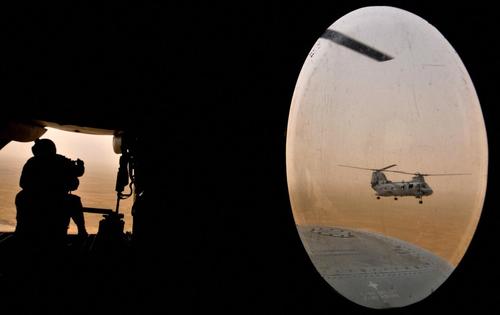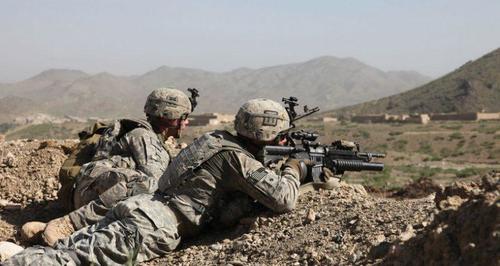Escobar: An Empire In Love With Its Afghan Cemetery
Authored by Pepe Escobar via The Asia Times,
The New Great Game 3.0 is just beginning with a hat tip to Tacitus and dancing to the Hindu Kush groove…
One cannot but feel mildly amused at the theatrical spectacle of the US troop pullout from Afghanistan, its completion day now postponed for maximum PR impact to 9/11, 2021.
Nearly two decades and a staggering US$2 trillion after this Forever War was launched by a now immensely indebted empire, the debacle can certainly be interpreted as a warped version of Mission Accomplished.
“They make a desert and call it peace,” said Tacitus – but in all of the vastness of the Pentagon there sits not a single flack who could imagine getting away with baldfacedly spinning the Afghan wasteland as peaceful.
Even the UN bureaucratic machinery has not been able to properly account for Afghan civilian deaths; at best they settled for 100,000 in only ten years. Add to that toll countless “collateral” deaths provoked by the massive social and economic consequences of the war.
Training and weaponizing the – largely inefficient – 300,000-plus Afghan Army cost $87 billion. “Economic aid and reconstruction” cost $54 billion: literally invisible hospitals and schools dot the Afghan landscape. A local chapter of the “war on drugs” cost $10 billion – at least with (inverted) tangible results: Afghanistan now generates 80% of the world’s opium.
All these embarrassing facts disappear under the shadow play of 2,500 “official” departing troops. What really matters is who’s staying: by no means just a few out of some 17,000 “contractors,” over 6,000 of whom are American citizens.
“Contractor” is a lovely euphemism for a bunch of mercenaries who, perfectly in tune with a shadow privatization drive, will now mingle with Special Forces teams and covert intel ops to conduct a still lethal variation of hybrid war.
Of course this development won’t replicate those David Bowie-style Golden Years in the immediate post-9/11 era. Ten years ago, following the Obama-Petraeus surge, no fewer than 90,000 contractors were dancing to the Hindu Kush groove, lavishly compensated by the Pentagon and dabbling in everything from construction, transportation and maintenance to “enhanced interrogation services.”
Collectively, this shadow army, a triumph of private enterprise many times cheaper than the state-sponsored model, bagged at least $104 billion since 2002, and nearly $9 billion since 2016.
Now we’re supposed to trust CENTCOM commander General Kenneth McKenzie, who swears that “the U.S. contractors will come out as we come out.” Apparently the Pentagon press secretary was not briefed: “So on the contractors, we don’t know exactly.”
Some contractors are already in trouble, like Fluor Corporation, which is involved in maintenance and camp construction for no fewer than 70 Pentagon forward operating bases in northern Afghanistan. Incidentally, no Pentagon PR is explaining whether these FOBs will completely vanish.
Fluor was benefitting from something called LOGCAP – Logistics Civil Augmentation IV Program – a scheme set by the Pentagon at the start of Obama-Biden 1.0 to “outsource logistical military support.” Its initial five-year deal was worth a cool $7 billion. Now Fluor is being sued for fraud.
Enhancing stability forever
The current government in Kabul is led by a virtual nonentity, Ashraf Ghani. Like his sartorially glamorous predecessor Hamid Karzai, Ghani is a US creature, lording it over a rambling military force financed by Washington to the tune of $4 billion a year.
So of course Ghani is entitled to spin a rosy outlook for an Afghan peace process on the pages of Foreign Affairs.
It gets curioser and curioser when we add the incandescent issue that may have provoked the Forever War in the first place: al-Qaeda.
A “former security coordinator for Osama bin Laden” is now peddling the idea that al-Qaeda may be back in the Hindu Kush. Yet, according to Afghan diplomats, there is no evidence that the Taliban will allow old-school al-Qaeda – the Osama/al-Zawahiri incarnation – to thrive again.
That’s despite the fact that Washington, for all practical purposes, has ditched the Doha Agreement signed in February 2020, which stipulated that the troop pullout should have happened this past Saturday, May 1.
Of course, we can always count on the Pentagon to “enhance security and stability” in Afghanistan. In this Pentagon report we learn that “AQIS [al-Qaeda in the Indian Subcontinent] routinely supports and works with low-level Taliban members in its efforts to undermine the Afghan government, and maintains an enduring interest in attacking US forces and Western targets.”
Well, what the Pentagon does not tell us is how old-school al-Qaeda, pre-AQIS, metastasized into a galaxy of “moderate rebels” now ensconced in Idlib, Syria. And how contingents of Salafi-jihadis were able to access mysterious transportation corridors to bolster the ranks of ISIS-Khorasan in Afghanistan.
The CIA heroin ratline
All you need to know, reported on the ground, about the crucial first years of the imperial adventure in Afghanistan is to be found in the Asia Times e-book Forever Wars, part 1.
Two decades later, the politico-intel combo behind Biden is now spinning that the end of this particular Forever War is an imperative, integrated to the latest US National Security Strategy.
Shadow play once again reigns. Withdrawal conditionals include the incompetence and corruption of the Afghan military and security forces; that notorious Taliban-al-Qaeda re-engagement; the fight for women’s rights; and acknowledging the supreme taboo: this ain’t no withdrawal because a substantial Special Forces contingent will stay in place.
In a nutshell: for the US deep state, leaving Afghanistan is anathema.
The real heart of the matter in Afghanistan concerns drugs and geopolitics – and their toxic intersection.
Everyone with transit in the Dubai-Kandahar axis and its ramifications knows that the global-spanned opium and heroin business is a matter very close to the CIA’s heart. Secure air transport is offered by bases in Afghanistan and neighboring Kyrgyzstan.
William Engdahl has offered a concise breakdown of how it works. In the immediate post-9/11 days, in Afghanistan, the main player in the opium trade was none other than Ahmed Wali Karzai, presidential brother and a CIA asset. I interviewed him in Quetta, Balochistan’s capital, in October 2001 (the interview can be found in Forever Wars). He obviously did not talk about opium.
Ahmed Karzai was snuffed out in a Mafia-style hit at home, in Helmand, in 2011. Helmand happens to be Afghanistan’s Opium Central. In 2017, following on previous investigations by Seymour Hersh and Alfred McCoy, among others, I detailed the workings of the CIA heroin ratline in Afghanistan.
New Great Game 3.0 is on
Whatever happens next will involve layers and layers of shadow play. CENTCOM’s McKenzie, at a closed-door hearing at the US House Armed Services Committee, basically said they are still “figuring out” what to do next.
That will certainly involve, in McKenzie’s own assessment, “counter-terrorism operations within the region”; “expeditionary basing” (linguistic diversion to imply there won’t be any permanent bases, at least in thesis); and “assistance” to Afghan National Defense and Security Forces (no details on what this “assistance” will consist of).
Now compare it with the view by major Eurasian powers: Russia, China, Pakistan and Iran, three of them members of the Shanghai Cooperation Organization (SCO), with Iran as an observer and soon full member.
Their number one priority is to prevent any mutating Afghan jihadi virus to contaminate Central Asia. A massive 50,000 troop-strong Russia-Tajikistan military exercise in late April had exactly that in mind.
Ministers of defense of the Collective Security Treaty Organization (CSTO) met in Dushanbe with the objective of further fortifying the porous Tajik-Afghan border.
And then there’s the Turkmen-Afghan border, from which the opium/heroin trail reaches the Caspian Sea and diversifies via Russia, Kazakhstan and Azerbaijan. Moscow, even more than the CSTO, is particularly worried by this stretch of the trail.
The Russians are very much aware that even more than different opium/heroin routes springing up, the top danger is a new influx of Salafi-jihadis into the Commonwealth of Independent States (CIS).
Even if analyzing it from completely different perspectives, Americans and Russians seem to be equally focused on what Salafi-jihadists – and their handlers – may come up with in post-9/11, 2021 Afghanistan.
So let’s go back to Doha, where something really intriguing is afoot.
On April 30, a so-called extended troika – Russia, the United States, China and Pakistan – issued a joint statement in Doha on their discussions regarding a negotiated settlement in Afghanistan.
The extended troika met with the Kabul government, the Taliban and host Qatar. At least they agreed there should be “no military solution.”
It gets curioser and curioser again: Turkey, backed by Qatar and the UN, is getting ready to host a conference to further bridge the gap between the Kabul government and the Taliban. Realpolitik cynics will have a ball wondering what Erdogan is scheming at.
The extended troika, at least rhetorically, is in favor of an “independent, sovereign, unified, peaceful, democratic, neutral and self-sufficient Afghanistan.” Talk about a lofty undertaking. It remains to be seen how Afghanistan’s “neutrality” can be guaranteed in such a nest of New Great Game serpents.
Beijing and Moscow will be under no illusions that the newly privatized, Special Forces Afghan-American experiment will eschew using Salafi-jihadis, radicalized Uighurs or other instant assets to destabilize what in effect should be the incorporation of Afghanistan to the China-Pakistan Economic Corridor (CPEC), the Shanghai Cooperation Organization (where it’s already an observer) and the larger Eurasia integration project.
An extra-intriguing piece of the puzzle is that a very pragmatic Russia – unlike its historical ally India – is not against including the Taliban in an overall Afghan settlement. New Delhi will have to go along. As for Islamabad, the only thing that matters, as always, is to have a friendly government in Kabul. That good old “strategic depth” obsession.
What the major players – Russia and China – see in the framework of a minimally stabilized Afghanistan is yet one more step to consolidate the evolution of the New Silk Roads in parallel with the Greater Eurasia partnership. That’s exactly the message Russian Foreign Minister Sergey Lavrov delivered during his recent visit to Pakistan.
Now compare it with the – never explicit – strategic deep state aim: to keep some sort of military-intel “forward operating base” in the absolutely crucial node between Central and South Asia and close, oh so close, to national security “threats” Russia and China.
The New Great Game 3.0 is just beginning at the graveyard of empires.
Tyler Durden
Tue, 05/11/2021 – 00:10
via ZeroHedge News https://ift.tt/33C1W8Y Tyler Durden


